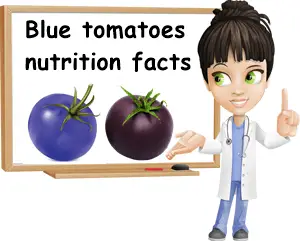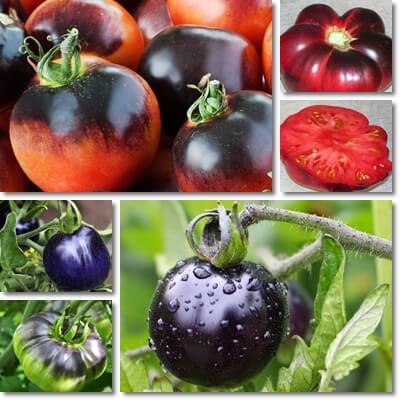Blue tomatoes, aka purple tomatoes, are a variety of tomato that ripens to a dark blue, purple blue or black blue color, sometimes with red purple.
Blue tomatoes have been developed to produce high amounts of anthocyanins, pigments with strong antioxidant properties and anti-inflammatory and even anticancer activity.
Eating blue tomatoes and blue foods in general provides antioxidant, anti-inflammatory and antiaging benefits as well as benefits for arthritis, gout, diabetes and cardiovascular health.
Are blue tomatoes real?
Believe it or not, blue tomatoes are a real tomato variety. While there are naturally occurring blue foods such as blueberries, blackberries, black raspberries etc., tomatoes are not naturally blue although they possess the genes to express the color.
Blue tomatoes are a product of conventional breeding and genetic modification, genetic modification producing the darker blue, more even colored tomatoes.
Genes from other plants such as snapdragons have been introduced to tomatoes to help them express the more unusual color, both in the skin and flesh.

What do blue tomatoes look like?
Despite their name, blue tomatoes are actually more of a dark blue, purple blue or black blue. There are quite a few different varieties as well, including regular size and cherry tomato varieties.
Some blue tomatoes have dark blue skin and some degree of blue flesh, while others have only dark blue skin and red or red purple flesh.
Some blue tomato varieties have dark blue with red purple skin (see pictures below).
What do blue tomatoes taste like?
Blue tomatoes have a rich, sweet, slightly astringent taste with earthy flavors, a bit different than regular red tomatoes. The reason they are more astringent is because of their anthocyanin content – anthocyanins make foods taste slightly astringent.
You can eat blue tomatoes safely both raw and cooked unless you are allergic in which case consumption of tomatoes in general is best avoided to prevent severe side effects such as anaphylactic shock.
Why do some tomatoes turn blue?
What causes some tomatoes to turn blue, purple blue or black blue instead of red is organic chemicals called anthocyanins. Tomatoes naturally have the genes for producing anthocyanins, but these are not expressed.
It required conventional breeding and genetic manipulation efforts to express these genes and stimulate the production of anthocyanin pigments to make blue tomatoes or, as some call them, purple tomatoes.
Both the dark blue and red purple colors in blue tomato varieties are produced by anthocyanins.

Blue tomatoes: why are they turning red?
Are you looking to grow blue tomatoes? Blue tomato seeds are available online, but before you buy them, look up the variety to make sure you are satisfied with the tomato you are going to get because not all blue tomatoes are dark blue, or entirely blue.
For example, if your blue tomatoes are turning red here and there instead of blue, or a red purple instead of blue, they may come from a variety that is not completely blue when ripe, or they may come from a hybrid variety that produces fruits with an inconsistent appearance.
Find out more about blue tomatoes.
Blue tomatoes nutrition facts
The most relevant nutritional information about blue tomatoes is their high content of anthocyanin antioxidants, the same pigments responsible for their intense color.
Blue tomatoes are good sources of vitamin C, vitamins E and K and several B vitamins as well as dietary fiber.
Blue tomatoes also contain good amounts of dietary potassium and manganese and modest amounts of magnesium and phosphorus. The botanical fruit is high in water, low in calories, fat and protein and a moderate source of carbohydrates and sugar.
Are blue tomatoes good for you?
What do blue tomatoes do for you in terms of health benefits? Like all other tomato colors, blue tomatoes are good for blood pressure and cardiovascular health in general, have an anti-inflammatory and immune system boosting action and provide benefits for constipation, weight loss and even diabetes. See below a list of the top benefits of blue tomatoes.
- Good food for healthy weight loss due to being low in calories and fat, and moderately satiating.
- Benefits for digestion and constipation relief thanks to a good dietary fiber and high water content.
- Tonic, energizing food as a result of a good carbohydrate, sugar and B vitamin content.
- Low glycemic index food with a GI score of around 15-20, blue tomatoes don’t raise blood sugar levels excessively when consumed reasonably.
- Good food for diabetics thanks to its limited effects on blood sugar and content of essential nutrients and antioxidants with benefits for diabetes management.
- Anticancer benefits: studies show anthocyanins in dark colored foods such as cherries and blue tomatoes have free radical scavenging, anti-proliferative, enzyme-activating, anti-angiogenesis, apoptotic and anti-invasiveness effects.
- Potential benefits for arthritis joint swelling and pain due to a high content of anthocyanins with scientifically proven anti-inflammatory action and pain-relieving action.
- Potential benefits for gout management: blue tomatoes are a low-purine food and high in anthocyanins, helping manage uric acid levels in the blood and control gout flareups.
- Benefits for high blood pressure: eating blue tomatoes actively helps lower blood pressure numbers thanks to a good magnesium and potassium content and being sodium-free.
- Cholesterol lowering properties owed to anthocyanins, dietary fiber and other polyphenols.
- Benefits for skin owed to anthocyanin antioxidants with anti-inflammatory, free radical scavenging and cell reparative properties.
- Antiaging benefits thanks to good amounts of vitamin C which stimulates the production of collagen for improved skin elasticity and fewer wrinkles.
- Immune boosting properties thanks to a good content of vitamin C, immuno-modulating anthocyanin antioxidants and other polyphenols.
